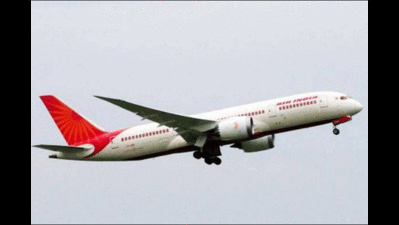- News
- City News
- mumbai News
- 'Psychiatric test' recommended after pilot move puts 200 lives at risk
Trending
This story is from September 2, 2016
'Psychiatric test' recommended after pilot move puts 200 lives at risk
A senior Air India executive commander prone to sudden, psychotic mood swings carried out an extremely unsafe manoeuvre onboard a Delhi-Paris flight on April 28 putting the Boeing 787 and the lives of over 200 passengers and crew at risk.

(Representative image)
Key Highlights
- A senior Air India executive commander n April 28 manipulated the onboard flight management computer and initiated a climb beyond the aircraft’s altitude capability
- However, the airline has now formed a panel which might let him go scotfree
MUMBAI: A senior Air India executive commander prone to sudden, psychotic mood swings carried out an extremely unsafe manoeuvre onboard a Delhi-Paris flight on April 28 putting the Boeing 787 and the lives of over 200 passengers and crew at risk.
A panel formed to probe the incident concluded last month that the commander should undergo psychiatric evaluation and thereafter fly only as a co-pilot for six months, during which his behaviour should be under check.The commander is currently grounded, but the airline has formed another committee to relook the case and there are apprehensions he may get a clean chit.
Unlike the Germanwings March 2015 crash in which a suicidal co-pilot locked out the commander and flew into the French Alps killing all 150 people on board, in the Air India case, it was the copilot who raised an alarm.
On April 28, the commander, for reasons unknown, manipulated the onboard flight management computer and initiated a climb beyond the aircraft’s altitude capability.
“Even as the commander started the climb, the co-pilot objected. But he disregarded the co-pilot’s advice and the aircraft came close to stall speed,” said a source. “Luckily for its crew and passengers, the aircraft was brought down to a safer altitude.”
The co-pilot later reported the incident. “An inquiry was ordered, which subsequently discovered a number of other incidents where the commander’s behaviour had come across as mercurial, unstable and temperamental, a trait considered unsafe for a pilot,” a source said.
In the last 2-3 years, the frequency of such cases had gone up. The inquiry panel said it would be unsafe to overlook his behaviour pattern and recommended a psychiatric assessment by IAF doctors.
However, the airline, instead has constituted a new panel. “Two of the three members in this panel are known to be close to the commander and they might let him go scotfree and let him back into the cockpit in command,” said a source. The AI spokesperson was sent a questionnaire, but the airline did not respond.
A panel formed to probe the incident concluded last month that the commander should undergo psychiatric evaluation and thereafter fly only as a co-pilot for six months, during which his behaviour should be under check.The commander is currently grounded, but the airline has formed another committee to relook the case and there are apprehensions he may get a clean chit.
Unlike the Germanwings March 2015 crash in which a suicidal co-pilot locked out the commander and flew into the French Alps killing all 150 people on board, in the Air India case, it was the copilot who raised an alarm.
On April 28, the commander, for reasons unknown, manipulated the onboard flight management computer and initiated a climb beyond the aircraft’s altitude capability.
This would have taken the aircraft into what’s commonly called the “coffin corner” — the altitude at which an aircraft becomes unstable and the flight controls offer no help. Once at this altitude, any reduction in airspeed would cause the aircraft to stall, but if the speed is increased (to prevent the stall) the aircraft could suffer structural damage. So either way the aircraft is at risk.
“Even as the commander started the climb, the co-pilot objected. But he disregarded the co-pilot’s advice and the aircraft came close to stall speed,” said a source. “Luckily for its crew and passengers, the aircraft was brought down to a safer altitude.”
The co-pilot later reported the incident. “An inquiry was ordered, which subsequently discovered a number of other incidents where the commander’s behaviour had come across as mercurial, unstable and temperamental, a trait considered unsafe for a pilot,” a source said.
In the last 2-3 years, the frequency of such cases had gone up. The inquiry panel said it would be unsafe to overlook his behaviour pattern and recommended a psychiatric assessment by IAF doctors.
However, the airline, instead has constituted a new panel. “Two of the three members in this panel are known to be close to the commander and they might let him go scotfree and let him back into the cockpit in command,” said a source. The AI spokesperson was sent a questionnaire, but the airline did not respond.
End of Article
FOLLOW US ON SOCIAL MEDIA











